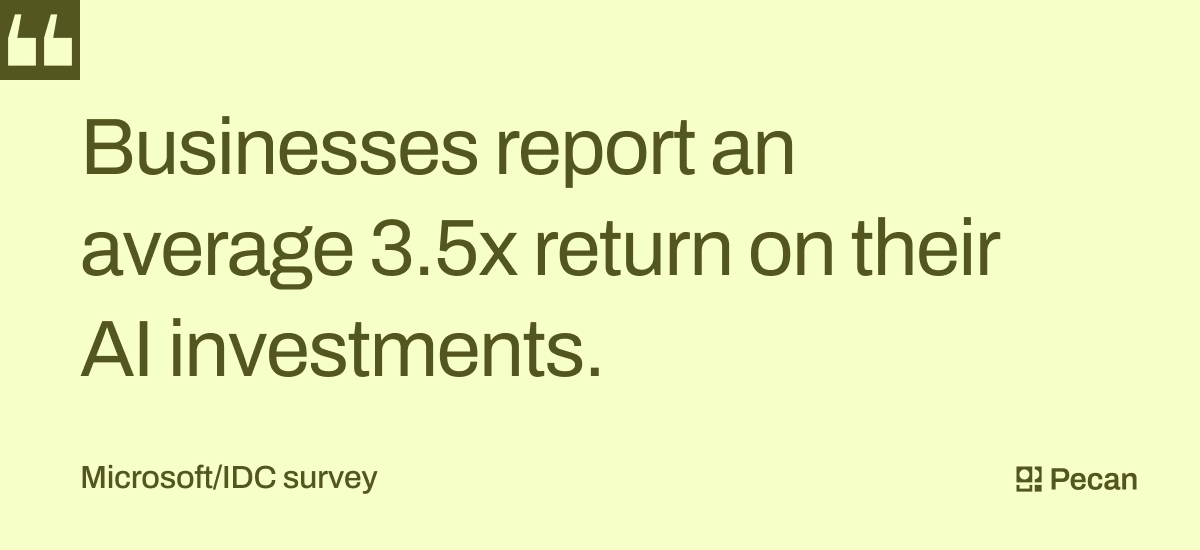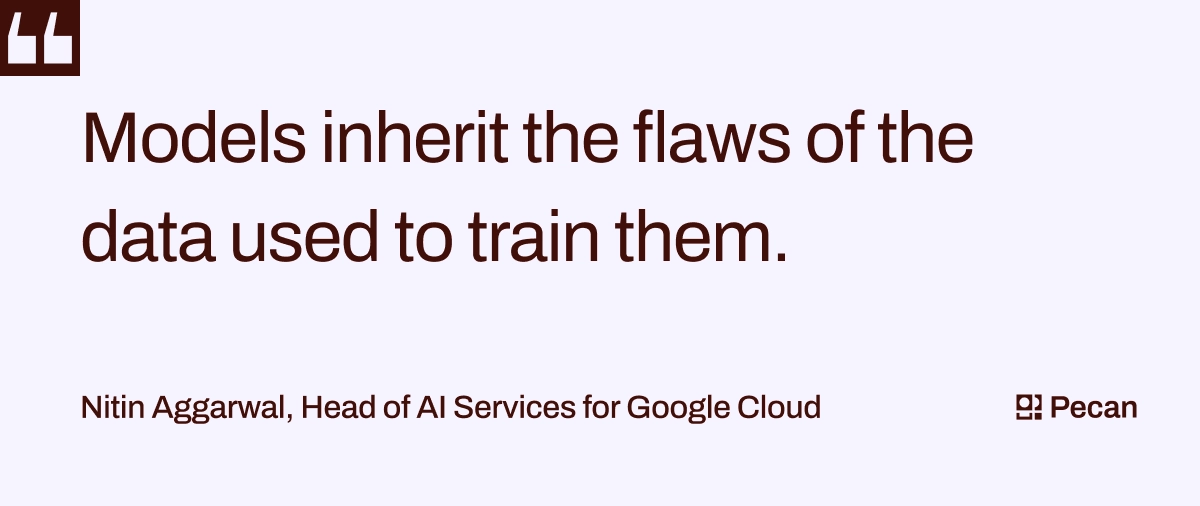In a nutshell:
- CDAOs are investing in AI to automate data analytics processes and improve business operations.
- GenAI can help extract powerful insights and make accurate predictions, leading to substantial ROI.
- Calculating ROI involves cost savings, revenue generation, and total cost of ownership.
- Choosing the right KPIs and tracking them regularly is crucial for measuring AI project success.
- Challenges in measuring ROI include workforce requirements, data quality, and capturing the impact of AI tools for marketing purposes.
Unless you’ve been hiding under a rock, you’ve been inundated and perhaps even overwhelmed by the world of artificial intelligence. There’s no denying that AI and GenAI have been rapidly advancing and impacting the field of data analytics in massive ways.
While there’s a lot of hype out there, CDAOs like you must ensure they’re leading their organizations to success. To do this, it’s essential to make decisions based on data — both external data on AI usage and impact and internal data on business and talent needs and potential ROI. In other words, you must qualify and quantify your AI investment with data that proves its value.
“In 2026, 75% of CDAOs that have failed to make organization-wide influence their top priority will have been assimilated back into technology functions.”
— “The Gartner Predictions for 2024: Data & Analytics,” Gartner
In this article, we’ll dive into why CDAOs are investing in AI and how you can justify your AI investments with a clear understanding of key performance indicators and potential ROI.
Why CDAOs are investing in AI
Data and analytics leaders the world over may be wondering just how to harness the power of AI to automate and streamline their data analytics processes. Of course, there’s infinite potential here to improve business operations by taking some of the more mundane computational tasks off your plate.
After all, there’s so much that AI can do for your data analytics business:
- Data preprocessing
- Data visualization
- Extracting data insights
- Predictive analytics
- Prescriptive insights
- Generating code for your models
- Choosing the right features for your models
- And more
AI shines when it comes to automating and analyzing at scale, pointing to insights and predictions that may have taken longer to determine without the power of machine learning. When these tasks are no longer taking up precious time, it can make space for more important tasks requiring a human brain and an artful touch.
However, the real special sauce lies in using AI to extract powerful insights and make more accurate predictions. GenAI has made this increasingly possible and potent.
The rise of GenAI
We know GenAI is going to be transformative. 31% of the leaders surveyed in a Deloitte report expect a substantial transformation in less than twelve months. In addition, a Microsoft-sponsored study on the business opportunities of AI looked at how leading organizations are using AI to achieve results across industries. The study revealed that, for every $1 a company invests in AI, it realizes $3.50 (on average) in return.
The ROI on AI initiatives can be significant
That said, GenAI won’t replace workers. Rather, it’s a tool to help employees do more with less, accomplishing more strategic work than busy work.
There’s a way to think about this called HITL, or human in the loop. Essentially, this concept involves humans and machines working together, with human interaction and curation rather than zero human influence. This is the type of GenAI CDAOs are interested in.
Here are a few of the benefits you can expect with your AI investment:
Faster insights
AI makes quick work of automatically surfacing insights from data. Some providers like Pecan even offer Predictive GenAI tools that can rapidly iterate machine learning models through natural language. The result? More accurate insights more quickly, which can help data leaders make data-driven decisions to move their businesses forward.
Helping workers do more with less
Some of the most time-consuming tasks in data analytics include prep + blend and building reports. AI tools can automate these pre- and post-analytic steps and then streamline every part of the data science process (feature engineering, selecting the right model, coding, and validating the model). In a nutshell, AI can help workers write lightning-fast code and build and iterate on models with impressive accuracy and less manual work.
Bridging data science skills gaps
Certain AI tools can provide a bridge between analysts’ skills and data science. In other words, companies no longer require in-depth data science knowledge, experience, or advanced coding expertise to benefit from predictive analytics. The best platforms integrate today’s top predictive analytics capabilities with low-code options to make predictive modeling intuitive, accessible, and fast.
For example, low-code predictive analytics platforms like Pecan can help analysts build models with basic SQL knowledge but without requiring knowledge of Python or R. This can help teams make the most of their existing employees while still evolving their capabilities.
Chart your ROI roadmap
Just as you would put measurement tactics in place for a marketing campaign or your organization’s finances, you need a plan in place to track the ROI of your AI investments.
A Microsoft-sponsored study on the business opportunities of AI looked at how leading organizations are using AI to achieve eyebrow-raising results across industries. The study revealed that 92% of AI deployments take only 12 months or less. That means that most companies begin to see a return on their initial investment in less than a year. For 40% of organizations, that timeline was cut in half.
This means there’s a good chance you’ll start seeing a positive return on your AI investment in about a year. Yet, there’s still good reason to establish measurement benchmarks.
Consider another statistic from the same IDC study: 43% of organizations plan to reduce spending in other areas of the business to reallocate spending toward AI. That is, your organization may not be fully prepared to sink cash into an AI initiative just yet. And if leaders are pulling money from elsewhere in the organization (administrative support, tech support, HR, and customer service departments, for example), there’s even more need to be sure the ROI is there to justify the investment.
How to calculate the ROI of your AI project
It’s up to you to ensure that the ROI of your AI project adds up to be worthwhile. Here’s a formula we like to use to help determine the ROI of an AI investment:
ROI = Cost Savings + Revenue – Total Cost of Ownership (TCO)
ROI calculation formula
Cost savings
Cost savings can be measured in labor hours saved and money saved on other solutions.
Labor hours can add up, especially when you’re talking about seasoned data pros. After all, you need folks like this in your organization — but not for the menial tasks that AI tools can do for you.
ROI can also come in the form of cost savings from not having to go with multiple solutions in the tech stack. AI platforms, like Pecan, have multiple capabilities within a single SaaS solution. So, there’s no need to spend additional money seeking out and implementing various solutions.
Money made
You can calculate projected revenue both by productivity gains and the results of deeper insights. A Microsoft survey showed that 64% of employees don’t have enough time and energy to get their work done—and those employees are 3.5x more likely to say they struggle with being innovative or thinking critically.
What’s more, 70% of people would delegate as much work as possible to AI to lessen their workloads.
When AI takes the burden of these tedious tasks off their plate, professionals can take a breath and focus their attention on tasks that require problem-solving, critical thinking, and creativity — all essential tasks that you need humans for.
For dollars generated by AI-powered insights, we recommend using the statistic from earlier: For every $1 a company invests in AI, it realizes an average of $3.50 in ROI.
Total cost of ownership
TCO is a helpful metric for gauging the entire cost of the technology or system you purchase. Initially, you’ll face upfront licensing costs, training costs, and the cost of deployment and integration. Over time, you may have operating costs, such as maintenance and support fees. All of these factors play into your TCO.
How to choose the right KPIs
In addition to calculating the ROI of your AI investment, it’s critical to establish KPIs early in the process of AI implementation. This way, you can continue to refine and improve how you use AI, as well as how you measure success, both for your department and other departments whose analytics you support and subsidize.
Be sure to choose the best and most relevant KPIs that match your business goals and objectives. The right KPIs will help ensure that your organization is staying on track with its implementation of AI initiatives, making sure that the cost of the implementation and actual results are on par with expectations.
As with any performance indicators, it’s important to note that there are both direct and indirect measures of success.
Direct performance indicators are generally easily observable and measurable. Here are a few ideas to get started:
- Cost Savings: Evaluate the cost savings you've achieved through automation, process optimization, or resource optimization enabled by AI. These savings could include reduced labor costs, increased operational efficiency, or optimized resource utilization.
- Revenue Increase: Measure the revenue increase attributable to AI-driven initiatives. You might look at improved customer acquisition, cross-selling, up-selling, or personalized recommendations to AI-defined customer segments.
- Productivity Gains: Assess the productivity improvements resulting from AI applications, such as faster decision-making, time savings on tasks, lower error rates, or increased output.
- Customer Satisfaction and Retention: Track metrics related to customer experience, such as customer satisfaction scores (CSAT), net promoter scores (NPS), or customer retention rates. Investments in AI-powered personalization, recommendation engines, or chatbots could affect these metrics.
- Marketing Effectiveness: Evaluate the performance of AI-powered marketing campaigns, such as lower cost per acquisition (CPA), higher conversion rates, or return on advertising spend (ROAS).
- Operational Efficiency: Assess improvements in overall operational efficiency, such as reduced cycle times, increased throughput, or optimized resource allocation, enabled by AI-driven process optimization.
Additionally, some indirect and even qualitative factors, such as improved decision-making, risk mitigation, or competitive advantage, can also be considered when evaluating the overall value of AI initiatives.
It's also crucial to establish a regular schedule for tracking and reviewing KPIs. Do this regularly to identify trends, spot potential issues early, and make necessary adjustments.
Challenges in measuring the ROI of AI projects
Measuring the ROI of AI isn’t without its challenges. Here are a couple to keep in mind.
Workforce requirements
Getting results from your AI investments requires skilled workers to run these systems. Be sure you have the human resources available to get the projected benefit from your AI tools.
Data requirements
Especially when it comes to implementing AI tools, the data that you present must also be as clean and curated as possible. Maintaining a high-quality data environment is critical to your AI tools’ success.
Data quality is critical to AI success
Nitin Aggarwal, Head of AI Services for Google Cloud, puts it this way: “Models inherit the flaws of the data used to train them. Without proper data governance, models can easily be trained on low-quality, biased, or irrelevant data, increasing the chances of hallucination or problematic outputs.”
Any data used to feed AI tools should be properly labeled, organized, and monitored. Depending on how a business manages its data from the get-go, this may be either a small shift in operations or a massive challenge to your business’s internal process.
Capturing the story with the strength of numbers
When making the case for an AI investment, make sure to highlight all the numbers involved. They speak loud and clear. In addition, consider the fact that workers want to use AI. According to one study:
“As many as two-thirds of respondents said that they think AI skills will improve their career options and make them more employable. Furthermore, over half [57%] want their company to provide the training needed to get the skills they need. That is not just in the interest of the employee, but of the company, given that the cost of hiring a new worker can be as much as seven times that of upskilling an existing employee.”
Make sure to articulate that adopting AI tools and teaching workers how to use them is an integral part of talent retention and organizational success.
Demonstrate your expertise to customers
Measuring the impact of AI tools in your business is not only important to your overall business operations; capturing the numbers can result in an interesting and impactful marketing piece.
In fact, describing the return on investment from AI tools and how those tools are positively impacting your business can be a great case study for your own company. Not only is it useful for your customers, clients, or partners to see how you’re thoughtfully measuring and managing your technology, but this type of transparency can demonstrate the value of AI and leaders like you who put effort and time into making it successful.
Pecan makes costs manageable for higher ROI
Pecan's Predictive GenAI platform offers fast, simple integration with all major cloud providers and a low-code interface that lets analysts start building models without extensive coding knowledge. Pecan’s easy-to-use dashboards offer straightforward comparisons to relevant models and guidance for understanding and acting upon the model’s predictions.
Plus, Pecan is fast. Prebuilt integrations make getting up and running easy, while built-in generative AI features let users select a business problem and generate a SQL-based model in minutes—just using natural language. With those time savings, users can iterate and experiment or spend more time fine-tuning. Most modeling capabilities prepare and train models in 15 minutes or less. That means that, as soon as you begin, you can start measuring ROI.
Ready to learn how Pecan AI can help your team turn data into value? Request a demo today.






